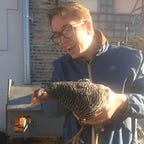Art Show at the Hacker Conference
This weekend, myself and a small group of artists & hackers co-organized an art show at Chicago’s THOTCON 0x9 hacker conference. Members from our loose collective, called pwnbrew club have been participating in the con for the past few years and we’ve been eager to find ways to bridge the gap between creative work in the fields of cybersecurity and contemporary art.
The show, titled artWare Hackers, featured works by digital artists who are working with computers, networks, and topics of surveillance, security, and privacy in unconventional ways. Our curation preferenced interactive and real-time techno-political artwork that addresses themes of privacy and information security. The goal of the show was to introduce members of the cybersecurity community to artists who are working with similar ideas and technologies through a different lens and with different forms of creative output.
If you didn’t get a chance to make it to the show, we’ve created this here blog post to document the event and share the work with you online. The show featured artworks by six practicing artists: Tom White, Branger_Briz, Brett Ian Balogh, Ingrid Burrington, Maddy Varner, and Mark Beasley.
Treachery of Imagenet, Tom White, 2017–2018
This series of prints fools modern computer vision and object detection systems into misclassifying abstract works of art as common real-life objects. These generative prints have been created to “target” six state-of-the-art algorithms trained using the standard ImageNet dataset. The series is a nod to René Magritte’s Treachery of Images, or This is Not a Pipe painting, which is a famous example of a self referential work of art.
Tom also created 100 new hot dog prints commissioned for and sold exclusively at THOTCON 0x9.
Prints from this series are available for purchase at https://dribnet.bigcartel.com/.
WiFi Data Safari, Branger_Briz, 2018
WiFi Data Safari is a critical software art project that aims to educate the public about the wireless network data that constantly surrounds them. The software captures 802.11 WiFi probe request packets from passersby devices that are silently exposing personal information about their owner’s previously connected WiFi networks and the physical locations where they may work, live, and play. Through a metaphor of butterfly collection, this data is presented as a wireless habitat, where nearby WiFi devices appear as unique butterflies with “migration patterns” derived from publicly accessible war driving data. Flowers in the scene represent nearby WiFi networks and clouds represent DNS requests made from devices associated with the “WiFi Data Safari” network hosted by the Wilderness Wireless router also located in the exhibition.
This project is often accompanied by a workshop where the artists lead a small group on an outdoor walking tour of their wireless surroundings. The software is also open source.
Wilderness Wireless, Brett Ian Balogh, 2017
This solar-powered WiFi router was created to encourage off-the-grid experimentation with wireless technologies. Radio, as a phenomenon, is a natural resource not unlike the air, land and water, and this piece is intended to remind us of that. Wilderness Wireless is a set of open source hardware schematics and DIY electronics that can be used to create ad-hoc local area networks in the great outdoors. Here, we are using it to host the WiFi Data Safari artwork also included in this exhibition. This device has been configured to create the “WiFi Data Safari” network and capture WiFi data in the area.
The Wilderness Wireless router is an open source hardware project. You can find instructions and files to build your own on GitHub.
Networks of New York, Ingrid Burrington, 2016
Networks of New York is an illustrated field guide to urban Internet infrastructure. This research project serves to foreground the physical components that make up the Internet and gives the reader the tools necessary to discover the cryptic unlabeled devices, manhole covers, antennas, and more scattered around their city.
Networks of New York is for sale by Melville House Publishing.
Kardashian Krypt, Maddy Varner, 2014
Kardashian Krypt is a steganographic browser extension that covertly encodes and decodes messages into images of Kim Kardashian. Stenography is the practice of concealing a message or file within another message or file in order to transmit it secretly in plain site.
Maddy Varner’s work often resides at the intersection of digital politics and pop culture. In an artist talk she gave at the Studio for Creative Inquiry at Carnegie Mellon University entitled Selfies & Security she said, “If we’ve done anything to normalize surveillance culture it’s through the way we treat our public figures.” This could not be more true than it is with Kim Kardashian. In this conceptual, but also useful, browser extension Varner leverages Kardashian’s status, “as perhaps one of the most public persons in the world as a mode of secrecy and covert communication.”
Ad Nauseam, Mark Beasley, 2016
Ad Nauseam is a browser extension artwork that creates a unique flag for each user from the targeted advertisements they receive while browsing the web. Ad Networks opaquely fingerprint and track user’s browsing history, collecting expansive profiles attempting to represent their wants and needs. The flags created by this project highlight the unique advertising experiences we each experience online due to the harvesting of personal data. All profits generated from ads served by the browser extension for the purpose of creating personalized flags are donated to the EFF.
That’s a Wrap
We had a blast sharing and talking about this work with the attendees of THOTCON this year and it seems like the show was well received. We’d love to make this a recurring component of THOTCON, or bring a similar show to another hacking event in the future. Do you run a conference? Let us know :)
I’d also like to thank all of the artists for loaning pwnbrew club their work so that we could share it with others. And of course, thanks to the organizers who put this show together: Will Robertston, Brannon Dorsey, Nick Briz, Nicholas Davis, and Jon Satrom.
